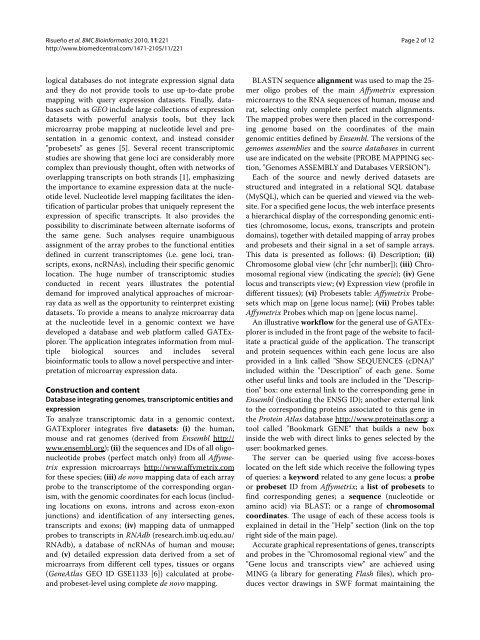Alberto Risueño Pérez - Gredos - Universidad de Salamanca
Alberto Risueño Pérez - Gredos - Universidad de Salamanca
Alberto Risueño Pérez - Gredos - Universidad de Salamanca
Create successful ePaper yourself
Turn your PDF publications into a flip-book with our unique Google optimized e-Paper software.
<strong>Risueño</strong> et al. BMC Bioinformatics 2010, 11:221<br />
http://www.biomedcentral.com/1471-2105/11/221<br />
logical databases do not integrate expression signal data<br />
and they do not provi<strong>de</strong> tools to use up-to-date probe<br />
mapping with query expression datasets. Finally, databases<br />
such as GEO inclu<strong>de</strong> large collections of expression<br />
datasets with powerful analysis tools, but they lack<br />
microarray probe mapping at nucleoti<strong>de</strong> level and presentation<br />
in a genomic context, and instead consi<strong>de</strong>r<br />
"probesets" as genes [5]. Several recent transcriptomic<br />
studies are showing that gene loci are consi<strong>de</strong>rably more<br />
complex than previously thought, often with networks of<br />
overlapping transcripts on both strands [1], emphasizing<br />
the importance to examine expression data at the nucleoti<strong>de</strong><br />
level. Nucleoti<strong>de</strong> level mapping facilitates the i<strong>de</strong>ntification<br />
of particular probes that uniquely represent the<br />
expression of specific transcripts. It also provi<strong>de</strong>s the<br />
possibility to discriminate between alternate isoforms of<br />
the same gene. Such analyses require unambiguous<br />
assignment of the array probes to the functional entities<br />
<strong>de</strong>fined in current transcriptomes (i.e. gene loci, transcripts,<br />
exons, ncRNAs), including their specific genomic<br />
location. The huge number of transcriptomic studies<br />
conducted in recent years illustrates the potential<br />
<strong>de</strong>mand for improved analytical approaches of microarray<br />
data as well as the opportunity to reinterpret existing<br />
datasets. To provi<strong>de</strong> a means to analyze microarray data<br />
at the nucleoti<strong>de</strong> level in a genomic context we have<br />
<strong>de</strong>veloped a database and web platform called GATExplorer.<br />
The application integrates information from multiple<br />
biological sources and inclu<strong>de</strong>s several<br />
bioinformatic tools to allow a novel perspective and interpretation<br />
of microarray expression data.<br />
Construction and content<br />
Database integrating genomes, transcriptomic entities and<br />
expression<br />
To analyze transcriptomic data in a genomic context,<br />
GATExplorer integrates five datasets: (i) the human,<br />
mouse and rat genomes (<strong>de</strong>rived from Ensembl http://<br />
www.ensembl.org); (ii) the sequences and IDs of all oligonucleoti<strong>de</strong><br />
probes (perfect match only) from all Affymetrix<br />
expression microarrays http://www.affymetrix.com<br />
for these species; (iii) <strong>de</strong> novo mapping data of each array<br />
probe to the transcriptome of the corresponding organism,<br />
with the genomic coordinates for each locus (including<br />
locations on exons, introns and across exon-exon<br />
junctions) and i<strong>de</strong>ntification of any intersecting genes,<br />
transcripts and exons; (iv) mapping data of unmapped<br />
probes to transcripts in RNAdb (research.imb.uq.edu.au/<br />
RNAdb), a database of ncRNAs of human and mouse;<br />
and (v) <strong>de</strong>tailed expression data <strong>de</strong>rived from a set of<br />
microarrays from different cell types, tissues or organs<br />
(GeneAtlas GEO ID GSE1133 [6]) calculated at probeand<br />
probeset-level using complete <strong>de</strong> novo mapping.<br />
Page 2 of 12<br />
BLASTN sequence alignment was used to map the 25mer<br />
oligo probes of the main Affymetrix expression<br />
microarrays to the RNA sequences of human, mouse and<br />
rat, selecting only complete perfect match alignments.<br />
The mapped probes were then placed in the corresponding<br />
genome based on the coordinates of the main<br />
genomic entities <strong>de</strong>fined by Ensembl. The versions of the<br />
genomes assemblies and the source databases in current<br />
use are indicated on the website (PROBE MAPPING section,<br />
"Genomes ASSEMBLY and Databases VERSION").<br />
Each of the source and newly <strong>de</strong>rived datasets are<br />
structured and integrated in a relational SQL database<br />
(MySQL), which can be queried and viewed via the website.<br />
For a specified gene locus, the web interface presents<br />
a hierarchical display of the corresponding genomic entities<br />
(chromosome, locus, exons, transcripts and protein<br />
domains), together with <strong>de</strong>tailed mapping of array probes<br />
and probesets and their signal in a set of sample arrays.<br />
This data is presented as follows: (i) Description; (ii)<br />
Chromosome global view (chr [chr number]); (iii) Chromosomal<br />
regional view (indicating the specie); (iv) Gene<br />
locus and transcripts view; (v) Expression view (profile in<br />
different tissues); (vi) Probesets table: Affymetrix Probesets<br />
which map on [gene locus name]; (vii) Probes table:<br />
Affymetrix Probes which map on [gene locus name].<br />
An illustrative workflow for the general use of GATExplorer<br />
is inclu<strong>de</strong>d in the front page of the website to facilitate<br />
a practical gui<strong>de</strong> of the application. The transcript<br />
and protein sequences within each gene locus are also<br />
provi<strong>de</strong>d in a link called "Show SEQUENCES (cDNA)"<br />
inclu<strong>de</strong>d within the "Description" of each gene. Some<br />
other useful links and tools are inclu<strong>de</strong>d in the "Description"<br />
box: one external link to the corresponding gene in<br />
Ensembl (indicating the ENSG ID); another external link<br />
to the corresponding proteins associated to this gene in<br />
the Protein Atlas database http://www.proteinatlas.org; a<br />
tool called "Bookmark GENE" that builds a new box<br />
insi<strong>de</strong> the web with direct links to genes selected by the<br />
user: bookmarked genes.<br />
The server can be queried using five access-boxes<br />
located on the left si<strong>de</strong> which receive the following types<br />
of queries: a keyword related to any gene locus; a probe<br />
or probeset ID from Affymetrix; a list of probesets to<br />
find corresponding genes; a sequence (nucleoti<strong>de</strong> or<br />
amino acid) via BLAST; or a range of chromosomal<br />
coordinates. The usage of each of these access tools is<br />
explained in <strong>de</strong>tail in the "Help" section (link on the top<br />
right si<strong>de</strong> of the main page).<br />
Accurate graphical representations of genes, transcripts<br />
and probes in the "Chromosomal regional view" and the<br />
"Gene locus and transcripts view" are achieved using<br />
MING (a library for generating Flash files), which produces<br />
vector drawings in SWF format maintaining the
















